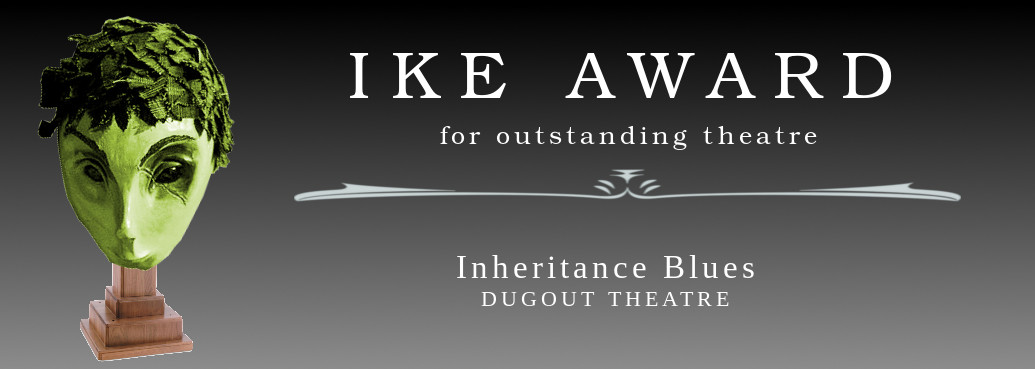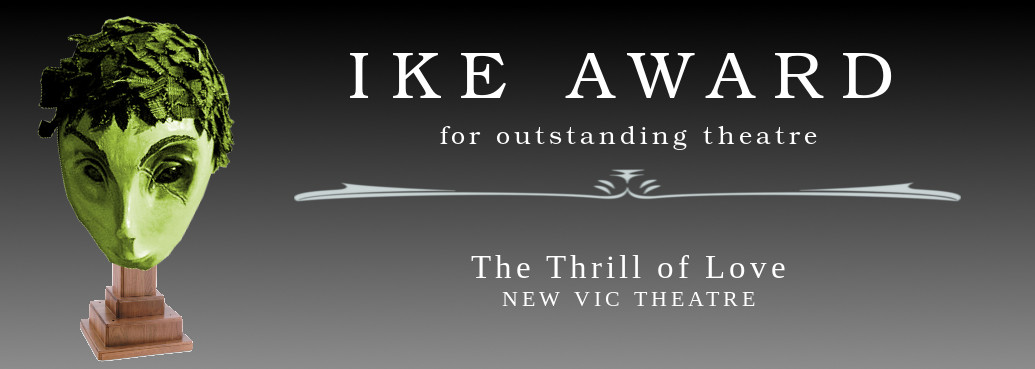Skip to: Blink, Samantha Mann, Inheritance Blues, Chaplin, Roundelay
Now we go into the third year of the blog, and the plays I rated as outstanding step up a notch. I’m not sure whether I was seeing more plays or getting a better radar for the good ones, but there was quite a haul.
2014 also was noted for a different reason, but we’ll get on to this later.

It is rare for me to rate a play as outstanding, but it’s even rarer for a play to get me emotional. Nabokov’s play is one of those rarities. There’s so many plays and films of “will they or won’t they get together?” (spoiler: yes, duh) I’ve long since been desensitised to it, and yet Phil Porter’s story of Jonah and Sophie has you desperately wanting these two the happiness they need. Both outsiders on the fringe of the society, they way they come to know each other is far from ordinary, something that would easily be misunderstood by an outsider, but the script always explains why they do what they do.

The thing that move the play from excellent to outstanding, however, way the ending. It might be the ending that no-one wanted, but it was the only ending that could have happened. A bog-standard love story would have ended with them getting together and living happily ever after – but real stories don’t end there. It’s a punch in the guts when the inevitable happens, but that’s the way things go sometimes.
Add to the this innovative set perfectly depicting the unreal, this could not have been a better start to the year.

I’ve been aware for a long time that, far from being two distinct genres, theatre and comedy have a big overlap, but it was this show from the comedy sections of Buxton and Edinburgh Fringe that I rated as outstanding on the terms I rate theatre. On the surface, Samantha Mann is drag character comedy from Charles Adrian on a fuddled middle-aged spinster doing a poetry reading. If she ever gets round to the poetry. In fact, she spends half an hour whittering away before getting to this poem.

But it’s in the whittering where the real stories. At first glance you might think she’s giving away past acecdotes of ineptness, but it’s deeper than that. Slowly an unhappy story is pieced together of Samantha Mann’s lonesome life. The shy spinster she is now is the product of distant parents, a fun brother, and a tragedy that comes out of nowhere, very cleverly disguised underneath the laughter. The final poem “Who goes there” is accidentally the most moving poem of her set. There have been companion pieces produced for the world of Samantha Mann since, but the original will always be unbeatable.

Student theatre has a notoriety for many reasons: badly executed, unoriginal, or mistakenly thinking they’re being deep and profound – and, boy, I’ve had my fair share of those. So Dugout Theatre is a prime example of how it can go right. I first saw them do a excellent faithful-but-menacing version of Patrick Marber’s Dealer’s Choice back when they were still students, and then I thought nothing of it until everyone started raving about their smash hit Inheritance Blues. And that, it turned out, was extraordinary. I’m not sure whether anyone in this cast of six had professional training, but I don’t need to lower the bar: this was a superb play easily at the same standard as full professionals.

The story is simple enough: a three-piece band come to play at a funeral, and after the wake they are trapped by a storm with the thee sons, with the one who was closest to his father trying to rope his brothers into an ill-advised scheme to run his late father’s hotel. But what made this play stand out was the music slickly combined with the story. Starting with the “Hot Air Ballues” observing the first between the three brothers and later getting drawn into the story themselves, it really comes into its own, especially the surrealistic re-enactments of the outlandish stories the favourite son of the departed believe about his dad. And yet, for all the bells and whistles attached to a funny play, there is a lovely poignant bitter-sweet ending.
I’ve seen most of Dugout’s plays they brought to the Edinburgh Fringe and loved all of them, but nothing could ever top Inheritance Blues. The last play that featured the Dugout ensemble as we know it was the aptly-named Swansong in 2017 – since they they have acted as producers for other solo plays, still to good standard, but never a replacement for the ensemble we know from their greatest hits. But Dugout Theatre harm thoroughly earned its place amongst the greatest fringe ensembles.

There’s a lot of plays going round at the moment about Charlie Chaplin, but the one I saw and loved has an obscure origin. ACE productions is based in Finland, operates all over the world, and the Edinburgh Fringe production was a rare foray into the UK. This really could have done with being a full-length production, but in the 75 minutes given they did a perfectly potted history of Charlie Chaplin, warts and all. How he began, how real events worked into his films, the suspiciously high correlation between the leading female role and who he’s currently copping of with, all culminating into his disgrace and exile from Hollywood.

It was the final chapter that was done the most memorably. Whilst some of his indiscretions come back to bite him, this play makes a lot of his naivety over the upcoming communist scare, with the iconic speech from The Great Dictator used against him in ways no-one could have foreseen. And closing footage was perfect too: Charlie Chaplin’s Honorary Award, his rehabilitation into Hollywood thankfully before he died. It’s a pity play was never heard of again, but what a one-hit wonder it was.

With so many successes under his belt, Alan Ayckbourn has set himself a huge task: how do you write something that doesn’t feel derivative of anything he’s written before? For me, this was achieved with Roundelay. At first glance this looks like a re-hash of Confusions – isn’t five one-act plays in two hours old hat now? – but there was one difference whose significance you must not underestimate: the five plays can be performed in any order. Indeed, the order is decided randomly for each performance. And, truly testament to Ayckbourn’s writing skills, the p[lays work in any order. One way round a play will plant a seed that forms crucial background knowledge in another play. The other way round, instead of a seed you get a revelation that changes what you thought you know about a story just gone.

It wasn’t perfect – perfection is not a requirement of an Ike Award. The Agent was, I thought, the weak link of the five, played for too many laughs at the expense of believability. But The Judge was wonderful, in my view better than any of the five famous plays from Confusions: an elderly man set up to meet a woman made up to look like his wife as she was when they first met. For some of Ayckbourn’s later plays, I’ve not shared the enthusiasm of the critics, but this one I think is a very underrated. Hope we have not seen the last of this.
But not …
2014 also had the dubious honour of being the year I saw a lot of terrible plays. I have a long-standing rule that I lay off low-key performances from low-key groups, but it’s bigger-budget performances from people who ought to know better are fair game. However, there was one play that scored the unholy trinity: no artistic merit, morally repellent, and a high-profile group that makes it open season. Looking for Paul achieves all three – I don’t know any other way a play can get me that angry.
As I’ve previously said, Paul McCarthy, the “artist” this play idolises, is someone I have a problem with. He’s a bit like Damien Hirst, inexplicably lauded by the fine arts world (and if you don’t like it it’s your fault for not being cultured), except that Damien Hirst does at least draw the line at shitting coloured diarrhoea on paper. Damien Hirst also has the defence that no-one’s forcing you to look at his spot painting. Not so for Paul McCarthy, who is the darling of “public art”, especially ones involving giant turds of butt-plugs. This is the entire premise of this play, a woman who objects to a butt-plug gnome outside her window and ends up getting roped into a closing scene that is disgusting for the sake of it. It appears to be a two-fingered salute to anyone expressing incorrect opinions about what they do and don’t want built on their doorstep.
The play (if we can call is a play – an opening forty-five minutes of reading out an exchange of emails is a tenuous claim) plays on the notion that controversy is good because It Provokes Debate™, a catch-all term used to invalidate any arguments to the contrary. It couldn’t be a bigger love-letter to Paul McCarthy if all the actors gave him a blow job on stage, nor that have been any more disgusting to watch than the final fifteen minutes. I suppose it’s a bit much to focus all my ire on either this play or the artist it celebrates – it’s more that embodies everything I hate about the elitist culture of contemporary fine art. Nothing I have seen since gets anywhere near my feelings for this – but don’t worry, when it finally happens I’ll certainly let you know.














